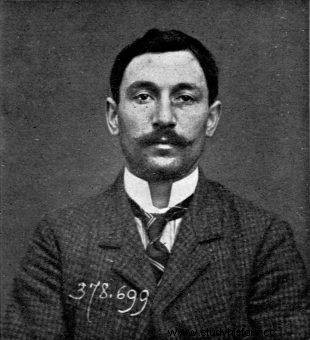Nobody needs to be convinced that in every museum there are collections valued at hundreds of thousands, millions and even billions (in all currencies). No wonder that art galleries with their gems are tasty morsels for thieves and criminals. What is surprising is the inadequate security around famous works of art to enable such audacious thefts.
One of the first robberies in the history of art is the capture of Hans Memling's triptych. The Last Judgment by ... Polish pirates, and more specifically - the crew of the karaka called Piotr from Gdańsk. The ship was commanded by a Gdańsk sailor, Paweł Beneke, and the looting took place in 1473 during the transport of the work to Italy. The conclusion is that the painting was certainly not intended to decorate Polish walls, but the triptych is still in the collection of the National Museum in Gdańsk , being the greatest cultural ornament of this city. And nobody really thinks about returning it to Italy.

One of the first robberies in the history of art is the capture of Hans Memling's triptych. The Last Judgment
While the ease with which paintings were stolen six hundred years ago may not be surprising, it is hard to believe that such robberies are still possible - especially in times of advanced security systems. Following the stories of famous thefts, one can even conclude that these were not particularly complicated operations.
Read also:Polish treasures looted during the Swedish Deluge. Where can they be viewed?
A daring jump after which only empty frames are left
The robbery of the Isabella Stewart Gardner Museum in Boston is considered to be the greatest theft of works of art. It took place on the night of March 18, 1990. Two men disguised as policemen came to the gallery claiming they had received a report of disturbing the order. This way they entered without any problems, and there they tied up and taped two guards who were then on the night shift, and locked them in the basement . Once they cleared the area, they could indulge in stealing. And they stole not just anything - they chose as many as thirteen artifacts, mainly paintings, but also sketches or a Chinese vase from the Shang dynasty and the crowning of the Napoleonic flag in the form of an eagle. The thieves took their time - they spent over an hour in the museum, quietly cutting canvases from the frames.

There are frames on the walls of the museum reminding us of the looting.
Among the stolen paintings were works by Vermeer, Manet, Degas and Rembrandt, one of the most famous artists, each work worth millions. Stolen objects are valued at around $ 500 million. To this day, none of them have been found - in their places there are only empty frames reminding of the looting, and the museum still offers ten million dollars for any information .
The robbers responsible for the robbery have never been caught, even though the FBI has been investigating for over twenty years. Clues even led to the Italian Mafia and the Irish Republican Army, but the leads turned out to be wrong and led nowhere. The greatest theft of works of art turned out to be one of the most unsolvable and mysterious mysteries.
To the glory of the Motherland!
According to some, the famous paintings warm the place not in these museums, as they should. For example, the Italian, Vincenzo Peruggia, who worked at the Louvre at the beginning of the 20th century, claimed this. He framed pictures there, so he had direct access to many works of art. At that time, the collection of the well-known French museum included the already iconic Mona Lisa. Peruggia couldn't resist the fact that the portrait painted by the outstanding Leonardo da Vinci did not add splendor to the interior of the Italian gallery. He decided to take it into his own hands - literally.
He knew the Louvre was closed on Mondays, so he hid in the museum on Sunday. It was August 20, 1911. On August 21, he came out of hiding, put on his work apron, went to the room where the Mona Lisa was hanging and ... he just pulled her off the wall . Before he escaped, he pulled off the frame and hid the painting under his apron. He left the museum unnoticed. For over a day, all employees and security guards were convinced that the Italian artist's masterpiece had ended up in a photo or conservation studio. So Peruggia could safely hide Mona Lisa in the suitcase, which he hid under his bed. The work was there for two years. At that time, the poet Guillaume Apollinaire and even Pablo Picasso were accused of theft.

Vincenzo Peruggia, Police Photography
Vincenzo Peruggia came up with his own request - in 1913 he returned to Italy and approached the famous antiquarian Alfred Geri, admitting that he had a stolen painting. Geri agreed to a meeting with Giovanni Poggi, director of the Uffizi Gallery. When they confirmed the authenticity of the portrait, they did not take it, and ... notified the police. Peruggia only spent seven months in prison. He claimed that returning the Mona Lisa to Italy was his patriotic dream, which made him almost like a national hero.
Read also:Art for excitement and pleasure, or a short history of nudes
Noble theft for a lesson
It is estimated that several billion pounds worth of works of art are lost each year, many of which have not been recovered or have been destroyed. And what is worth emphasizing, the theft is not always made by enthusiasts overwhelmed by their love of art. Sometimes it is about money, sometimes about mafia settlements, and sometimes thieves want to prove ... how poor security in museums is . This was the purpose behind the theft of paintings by Pablo Picasso, Vincent van Gogh and Paul Gauguin in April 2003.

Whitworth Art Gallery in Manchester
The works were brought from the Whitworth Art Gallery in Manchester and found three days later in a nearby public toilet, littered with graffiti, which the British press later dubbed "Loovre" to the Louvre). When the paintings were recovered, it was noticed that a note was attached to them in which the thieves wrote:" the intention was not to steal, but to make people aware of the defective security in the museum ". Although it was quite a brazen lesson, it's hard not to admit the perpetrators are right.
